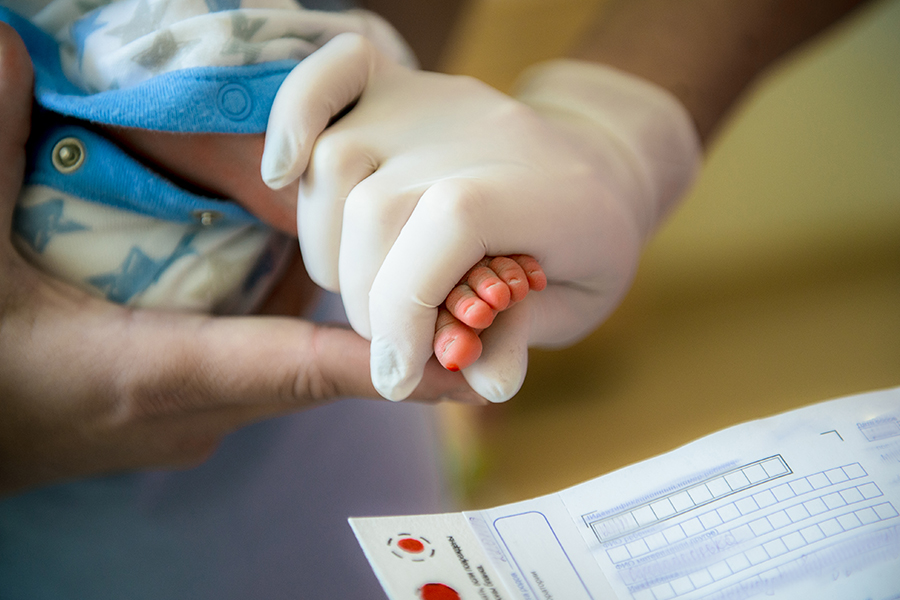Newborn Screening for Rare Immune Disorders Led to Earlier Treatment, Improved Survival
November 20, 2023
An NCATS-led Rare Diseases Clinical Research Network consortium charted the course of the disorders, developed lifesaving therapies and pioneered a screening test for newborns
In many ways, the Primary Immune Deficiency Treatment Consortium (PIDTC), a part of the NCATS-led Rare Diseases Clinical Research Network (RDCRN), has written the modern book on severe combined immunodeficiency (SCID). Termed the “bubble boy disease,” SCID causes infants to lack a working immune system. This leaves them susceptible to infections, with few ways to fight them.
SCID is a rare genetic disease that comes in different forms, each caused by mutations in genes for the development of infection-fighting immune cells. Without treatment to restore the immune system, children rarely live past two years of age.
Over the last 15 years, the PIDTC has charted the disease’s course and developed lifesaving therapies, including gene therapies. The PIDTC currently is made up of 49 collaborating medical centers and seven patient advocacy groups. The NIH’s National Institute of Allergy and Infectious Diseases, along with NCATS, provides funding support.
SCID’s standard treatment has been hematopoietic stem cell transplant from the most closely matched healthy donor available. Such stem cells develop into all types of blood cells, including infection-fighting white blood cells.
Slightly more than 70 percent of children receiving this treatment lived for more than five years. Doctors knew that children did better when they received stem cells before infections set in. But they lacked a way to identify children with SCID before they got sick.
Between 2005 and 2008, clinicians led by current PIDTC co-Principal Investigator Jennifer Puck, M.D., created a newborn screening test for SCID. It took another two years for the test to gain widespread use.
Reporting recently in The Lancet, PIDTC scientists revealed what doctors and families already suspected: Newborn screening for SCID saved lives. It identified infants with SCID earlier and led to faster treatment.
The study examined data on more than 900 children with SCID. PIDTC researchers found that widespread newborn screening for SCID, followed by early treatment, boosted the five-year survival rate of children with the disorder from 73% before screening began to 87%. Among children whose disease was suspected based on newborn screening rather than on getting sick or family history, 92.5% survived five years or more after treatment.
“SCID is the poster child for the benefits of newborn screening,” said co-author Donald Kohn, M.D., a pediatrician at the University of California, Los Angeles. Kohn has also been a co-Principal Investigator of the PIDTC.
“There have been incremental improvements in treatments over the decades, including better supportive care and new ways to suppress the immune system. None of this made a difference in survival until we began getting the patients in early because of newborn screening,” Kohn said. “Newborn screening has changed how patients are identified and now we’re having different conversations with parents.”
Puck, a clinician and researcher at the University of California, San Francisco (UCSF), was surprised by the latest results. “We set out to look at SCID over the decades,” she said. “We expected a gradual improvement, but instead noticed that survival since 1982 did not change until we got to 2010. Then it jumped up.”
The success of newborn screening for SCID points to a greater need for screening for a wider range of rare genetic diseases, said NCATS’ Tiina Urv, Ph.D., who oversees the RDCRN program.
“This study demonstrates the value of early identification and early treatment and should encourage investigators to develop new technologies for screening newborns,” said Urv. “We need different ways to expand the use of newborn screening. This can lead to a shorter route between diagnosis and treatment.”
Such concerns are hardly new. In 2021, dozens of scientists from academia, industry and government gathered at NIH for a 3-day meeting, led by NCATS, to discuss the present and future of gene-targeted therapies. Earlier this year, they published a series of articles highlighting issues focused in part on how to better identify individuals with rare diseases and provide better access to therapies.
PIDTC Alters SCID Landscape
PIDTC-led research has changed what is known about SCID and other immune deficiency disorders.
Scientists have tracked affected children for decades through natural history studies. These provided researchers with a new understanding of how the diseases can progress and change over the years. They’ve also developed new treatments, including promising gene therapies.
Kohn and his colleagues have developed an effective gene therapy for the form of SCID due to lack of the enzyme adenosine deaminase. Similarly, Puck and UCSF colleague Mort Cowan, M.D., have treated children with another type of the disorder -- Artemis deficient SCID -- with a different gene therapy. Developing therapies for rare diseases, including through U.S. Food and Drug Administration approval, remains a challenge. Thousands of disorders are so rare that companies are reluctant or unable to invest the years of research and millions of dollars needed to bring a dedicated gene therapy to market.
The PIDTC continues to innovate. It recently added a new category of diseases to the three they have been studying. Called primary immune regulatory diseases, they encompass more than 100 autoimmune disorders. Many of these can be chronic and life-threatening, such as type 1 diabetes. Another current research project examines ways to reduce the use of chemotherapy in a process called conditioning, which helps prepare patients before stem cell therapy. Conditioning makes it possible to grow new blood cells in the bone marrow.
“With NIH support, the PIDTC united a somewhat fractured immune deficiency research community by combining patients, resources, and experience,” said Kohn. “We’ve published foundational studies, developed life-changing therapies, proved the value of newborn screening and educated a new generation of scientists and clinicians. It’s been a great success.”



